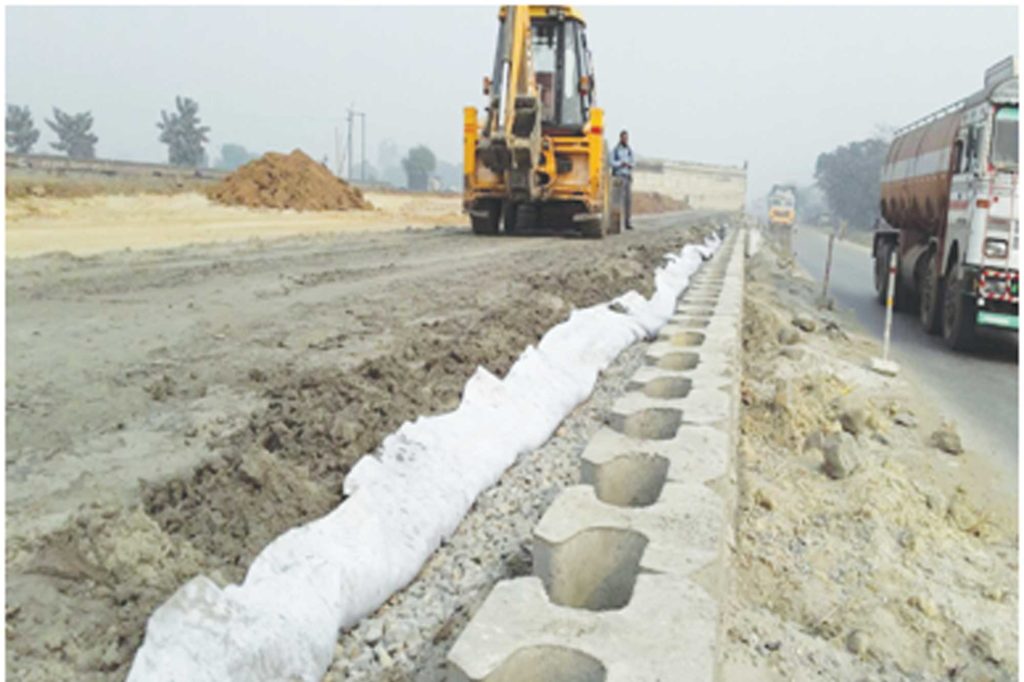Use of non-woven geotextile in roads and highways performs a number of benefits like separation, filtration, drainage and most importantly reinforcement.
Reinforcement
Problem
Pavement roads typically have asphalt or cement over the base layer of the aggregate which carries high traffic volume. Problems arise when the sub-grade consists of soft clays, silts and organic soil which in turn reduce the quality of the structure. When this type of structure becomes wet, it is unable to support traffic loads and eventually mixes with the road base aggregate thus degrading the road structure.
Solution (use of geosynthetics)
Soil geosynthetic aggregate (SGA) performs the following functions:
• Providing lateral spreading of the base.
• Increasing confinement and thus stiffness of the base.
• Improving vertical stress distribution on the sub-grade
• Reducing sheer stress in the sub-grade.
The Geosynthetic Materials Association (GMA) identified the determination of the Traffic Benefit Ratio (TBR) as the most common method for quantifying geosynthetic benefits.
TBR is the ratio of the reinforced load cycle at failure to the number of cycles that cause failure of un- reinforced road section. Geosynthetic has been found to provide a TBR of 1.5 to 70 depending on the type of geosynthetic and location of the road.
Geosynthetic materials are to be used as per MORTH Section 700.
Non-woven geotextile: Manas Non-woven Geotextile (MGT) performs the following function:
• Separation: MGT prevents the intermixing of the different layers of soil thus allowing each layer to distinctly perform its function.
• Drainage: MGT has excellent in-plane permeability. Non-woven geotextile acts as a medium and carries the water in the side ditches.
• Filtration: MGT acts as a filter under the road allowing water to flow freely and restricting soil and other particles to pass through it.
• Reinforcement: Non-woven geotextile helps in lateral dispersion of the soil and also evenly distributes the load thus increasing the load bearing capacity of the road.
Geogrid: Main functions of geo grid in pavement
• Lateral restrain: Mobilisation of friction and interlocking between base or sub-grade course and geosynthetic.
• Improved bearing capacity: Due to geo-synthetic, failure zone possesses higher volume and hence, increase in bearing capacity.
Tensioned membrane effect: Development of tension in geosynthetic due to wheel load resulting in vertical thrust.
Current projects
In the past two years, Manas Geo Tech India Pvt Ltd has worked with a number of consultants to promote the use of non woven geotextile and geogrid in sub-grade improvement.
Project Varanasi
Aurangabad at the Mohania site in Bihar, soil conditions at the site was weak with low CBR. Manas used non-woven geotextile in the sub-base to reinforce the same.
Road project in West Bengal
Non woven geotextile and geogrid have been very successful in stabilising the sub-grade.
Rehabilitation and upgradation of existing NH-67
Soil conditions in Nellore were very poor. Hence non-woven geotextile was used in the sub-grade to reinforce and increase the life span of the road.
For more details, visit
www.manasgeotextile.com
—————————————————————————-
Kartik Kanodia, Director, Manas Geo Tech India Pvt Ltd
Manas Geo Tech India Pvt Ltd is a one-stop solution provider for all your geosynthetic needs. We are a customer-driven industrial group that answers all civil engineering problems.
Cookie Consent
We use cookies to personalize your experience. By continuing to visit this website you agree to our Terms & Conditions, Privacy Policy and Cookie Policy.


















